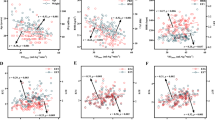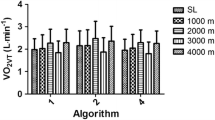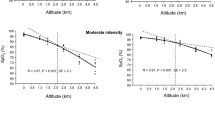Abstract
Purpose
Peak heart rate (HRpeak) is a common tool used in exercise prescription for groups in which maximal exercise intensity is contraindicated; however, the application of this method in normobaric hypoxia is unknown. Therefore, this study investigated the response of HRpeak and the application of predictive HRpeak equations to prescribe exercise intensity in acute normobaric hypoxia. Results were used to examine whether age-derived HRpeak predictive equations are valid in hypoxic conditions.
Methods
Fifteen untrained (eight men) volunteers (age 22 ± 2 years; peak rate of oxygen consumption 46.3 ± 7.0 ml kg−1 min−1) completed incremental cycle ergometer tests (randomised order) to measure HRpeak at sea-level (SL (ambient inspiratory oxygen fraction (FIO2) 0.209)) and four normobaric hypoxic conditions FIO2: 0.185, 0.165, 0.142, 0.125 (≈1,000–4,000 m).
Results
HRpeak was similar across all conditions (SL, 182 ± 13; 0.185, 178 ± 11; 0.165, 177 ± 9; 0.142, 178 ± 9; 0.125, 175 ± 10 b min−1) despite a reduction in oxygen saturation with increasing hypoxia (SL, 95 ± 5; 0.185, 95 ± 2; 0.165, 92 ± 2; 0.142, 88 ± 3; 0.125, 82 ± 4 %; P ≤ 0.05). The HRpeak was overestimated by all equations compared to the measured value (P < 0.05). Four equations overestimated HRpeak in all conditions (P < 0.01); two in four conditions (0.185, 0.165, 0.142, 0.125; P < 0.01); and two in three conditions (0.165, 0.142, 0.125; P < 0.01).
Conclusion
The overestimation of HRpeak by commonly used age-derived predictive equations in normobaric hypoxic conditions suggests that despite possible contraindications researchers should directly measure HRpeak whenever possible if it is to be used to prescribe exercise intensities.


Similar content being viewed by others
Abbreviations
- ANOVA:
-
Analysis of variance
- FIO2 :
-
Ambient inspiratory oxygen fraction
- HRpeak :
-
Peak heart rate
- O2 :
-
Oxygen
- PHRpeak :
-
Predicted peak heart rate
- RH:
-
Relative humidity
- RPE:
-
Rating of perceived exertion
- SL:
-
Sea level
- SPO2 :
-
Arterial oxygen saturation
- t amb :
-
Ambient temperature
- v :
-
Velocity
- \(\dot{V}_{E}\) :
-
Minute ventilation
- \(\dot{V}\rm{O_{2}}\) :
-
Oxygen uptake
- \(\dot{V}\rm{O_{2peak} }\) :
-
Peak rate of oxygen consumption
- \(\dot{W}_{peak}\) :
-
Peak power output
- Ω2 :
-
Omega squared
References
Aliverti A, Kayser B, Mauro AL, Quaranta M, Pompilio P, Dellaca RL et al (2011) Respiratory and leg muscles perceived exertion during exercise at altitude. Respir Physiol Neurobiol 177(2):162–168
Amann M, Subudhi AW, Foster C (2006) Predictive validity of ventilatory and lactate thresholds for cycling time trial performance. Scand J Med Sci Sports 16(1):27–34
Bailey DM, Davies B, Romer L, Castell L, Newsholme E, Gandy G (1998) Implications of moderate altitude training for sea-level endurance in elite distance runners. Eur J Appl Physiol 78(4):360–368
Benoit H, Busso T, Castells J, Geyssant A, Denis C (2003) Decrease in peak heart rate with acute hypoxia in relation to sea level VO2max. Eur J Appl Physiol 90(5–6):514–519
Bentley DJ, McNaughton LR (2003) Comparison Of Wpeak, VO2peak and the ventilation threshold from two different incremental exercise tests: relationship to endurance performance. J Sci Med Sport 6(4):422–435
Borg GAV (1982) Psychophysical bases of perceived exertion. Med Sci Sports Exerc 14(5):377–381
Buchfuhrer MJ, Hansen JE, Robinson TE, Sue DY, Wasserman K, Whipp BJ (1983) Optimizing the exercise protocol for cardiopulmonary assessment. J Appl Physiol 55(5):1558–1564
Burtscher M, Nachbauer W, Baumgartl P, Philadelphy M (1996) Benefits of training at moderate altitude versus sea level training in amateur runners. Eur J Appl Physiol 74(6):558–563
Cerretelli P (1980) Gas exchange at high altitude. In: West JB (ed) Pulmonary gas exchange, vol 1. Academic Press, New York, pp 97–147
Christensen EH, Forbes WH (1937) Der kreislauf in grossen höhen. Scand Arch Physiol 76:75–89
Cohen J (1992) A power primer. Psychol Bull 112(1):155–159
Field A (2005) Discovering statistics using SPSS (2nd Ed.) (pp. 294). London: Sage
Fox SM, Naughton JP, Haskell WL (1971) Physical activity and the prevention of coronary heart disease. Ann Clin Res 3(6):404–432
Franckowiak SC, Dobrosielski DA, Reilley SM, Walston JD, Andersen RE (2011) Maximal heart rate prediction in adults that are overweight or obese. J Strength Cond Res 25(5):1407–1412
Friedmann B, Frese F, Menold E, Bartsch P (2005) Individual variation in the reduction of heart rate and performance at lactate thresholds in acute normobaric hypoxia. Int J Sports Med 26(7):531–536
Grataloup O, Busso T, Castells J, Denis C, Benoit H (2007) Evidence of decrease in peak heart rate in acute hypoxia: effect of exercise-induced arterial hypoxemia. Int J Sports Med 28(3):181–185
Haufe S, Wiesner S, Engeli S, Luft FC, Jordan J (2008) Influences of normobaric hypoxia training on metabolic risk markers in human subjects. Med Sci Sports Exerc 40(11):1939–1944
Jones NL (1988) Clinical exercise testing (3rd edn., pp 303): WB Saunders, US
Jones NL, Makrides L, Hitchcock C, Chypchar T, Mccartney N (1985) Normal standards for an incremental progressive cycle ergometer test. Am Rev Respir Dis 131(5):700–708
Lawler J, Powers SK, Thompson D (1988) Linear relationship between VO2 max and VO2 max decrement during exposure to acute hypoxia. J Appl Physiol 64(4):1486–1492
Lundby C, Araoz M, van Hall G (2001) Peak heart rate decreases with increasing severity of acute hypoxia. High Alt Med Biol 2(3):369–376
Millet GP, Roels B, Schmitt L, Woorons X, Richalet JP (2010) Combining hypoxic methods for peak performance. Sport Med 40(1):1–25
Mollard P, Woorons X, Letournel M, Cornolo J, Lamberto C, Beaudry M et al (2007) Role of maximal heart rate and arterial O2 saturation on the decrement of VO2 max in moderate acute hypoxia in trained and untrained men. Int J Sports Med 28(3):186–192
Netzer NC, Chytra R, Kupper T (2008) Low intense physical exercise in normobaric hypoxia leads to more weight loss in obese people than low intense physical exercise in normobaric sham hypoxia. Sleep Breath 12(2):129–134
Perri MG, Anton SD, Durning PE, Ketterson TU, Sydeman SJ, Berlant NE et al (2002) Adherence to exercise prescriptions: effects of prescribing moderate versus higher levels of intensity and frequency. Health Psychol 21(5):452–458
Posner JD, McCully KK, Landsberg LA, Sands LP, Tycenski P, Hoffman MT et al (1995) Physical determinants of independence in mature women. Arch Phys Med Rehabil 76:373–380
Pugh LGCE (1964) Cardiac output in muscular exercise at 5800 m (19,000 ft). J Appl Physiol 19:441–447
Quintero P, Milagro FI, Campion J, Martinez JA (2010) Impact of oxygen availability on body weight management. Med Hypotheses 74(5):901–907
Ricard RM, Leger L, Massicotte D (1990) Validity of the “220-age formula” to predict maximal heart rate. Med Sci Sports Exerc 22(2):S96
Richalet JP, Larmignat P, Rathat C, Keromes A, Baud P, Lhoste F (1988) Decreased cardiac response to isoproterenol infusion in acute and chronic hypoxia. J Appl Physiol 65(5):1957–1961
Roach RC, Calbet JA, Olsen NV, Poulsen TD, Vissing SF, Saltin B (1996) Peak exercise heart rate in humans at high altitude. J Physiol 491:P60–P61
Robergs RA, Landwehr R (2002) The surprising history of the “HRmax = 220-age” equation. J Exerc Physiol Online 5(2):1–10
Roche F, Reynaud C, Pichot V, Duverney D, Costes F, Garet M et al (2003) Effect of acute hypoxia on QT rate dependence and corrected QT interval in healthy subjects. Am J Cardiol 91(7):916–919
Rosenthal R, Rosnow RL, Rubin DB (2000) Contrasts and effect sizes in behavioural research: a correlational approach. (pp 32). Cambridge University Press, Cambridge
Shephard RJ, Vandewalle H, Gil V, Bouhlel E, Monod H (1992) Respiratory, muscular, and overall perceptions of effort: the influence of hypoxia and muscle mass. Med Sci Sports Exerc 24(5):556–567
Stenberg J, Ekblom B, Messin R (1966) Hemodynamic response to work at simulated altitude, 4,000 m. J Appl Physiol 21(5):1589–1594
Tanaka H, Fukumoto S, Osaka Y, Ogawa S, Yamaguchi H, Miyamoto H (1991) Distinctive effects of three different modes of exercise on oxygen uptake, heart rate and blood lactate and pyruvate. Int J Sports Med 12(5):433–438
Tanaka H, Monahan KD, Seals DR (2001) Age-predicted maximal heart rate revisited. J Am Coll Cardiol 37(1):153–156
Acknowledgments
There were no external funding sources used in the preparation of this article. C. A Gallagher is currently receiving financial support in the form of a bursary allowance from the University of Chichester.
Conflict of interest
There are no conflicts of interests concerning the preparation of this article.
Author information
Authors and Affiliations
Corresponding author
Additional information
Communicated by Massimo Pagani.
Rights and permissions
About this article
Cite this article
Gallagher, C.A., Willems, M.E.T., Lewis, M.P. et al. The application of maximal heart rate predictive equations in hypoxic conditions. Eur J Appl Physiol 115, 277–284 (2015). https://doi.org/10.1007/s00421-014-3007-6
Received:
Accepted:
Published:
Issue Date:
DOI: https://doi.org/10.1007/s00421-014-3007-6




